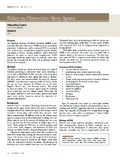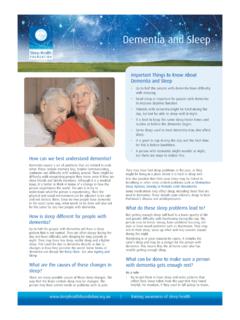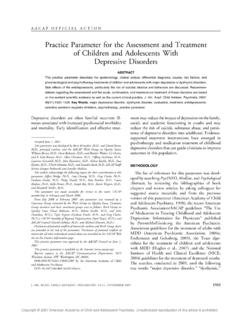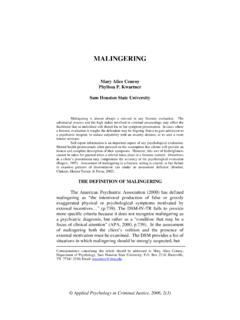Transcription of Sleep Apnea - - RN.org®
1 Sleep Apnea . Reviewed October, 2019, Expires October, 2021. Provider Information and Specifics available on our Website Unauthorized Distribution Prohibited 2019 , , , LLC. By Wanda Lockwood, RN, BA, MA. Purpose The purpose of this course is to provide the nurse with an understanding of the different types of Sleep Apnea , the causes, the symptoms, the diagnostic procedures, and the treatment options. Goals Upon completion of this course, the nurse should be able to do the following: Explain 3 changes that occur in the airways during Sleep . List at least 4 factors that contribute to Sleep Apnea . Explain the differences among obstructive, central, and mixed Sleep Apnea . Describe 3 breathing patterns associated with obstructive Sleep Apnea syndrome. Describe the breathing pattern associated with central Sleep Apnea . List and describe at least 5 illicit substances or drugs and their effect on Sleep . List at least 5 prescription drugs that can impair Sleep . Describe elements used in polysomnography.
2 Describe nocturnal PSG, Sleep diary, multiple Sleep latency test, and maintenance of wakefulness test. List and describe 3 assessment tools used to evaluate daytime sleepiness and/or fatigue. List and describe 4 types of positive airway pressure (PAP) devices. Discuss PAP titration. List and describe 4 common problems with PAP. List and describe 4 types of PAP interfaces. List and describe at least 6 other treatments used for Sleep Apnea . Introduction Dave began dozing off in the afternoon and evening and going to bed earlier but felt tired all the time. He woke up with a headache each morning and found it harder and harder to concentrate. He argued with his wife and co-workers and became increasingly unhappy and withdrawn. He lost interest in sex and, already overweight, started packing on more pounds. His snoring was so loud that his wife complained, finally insisting Dave see a doctor, who referred Dave to a Sleep center for polysomnography. Tests showed that Dave suffered from obstructive Sleep Apnea syndrome, characterized by loud snoring and periods of Apnea .
3 Dave's brain was not receiving adequate oxygenation during his Sleep , resulting in physical and psychological changes. About 12 million Americans suffer from Sleep Apnea (primarily obstructive Sleep Apnea ), and it is more common in males, especially those that are overweight, but by age 50, male and female rates are similar. Sleep Apnea not only disrupts Sleep , resulting in Sleep deprivation and excessive daytime sleepiness (EDS), but also causes hypertension and other disease. What is obstructive Sleep Apnea syndrome? Obstructive Sleep Apnea syndrome (OSAS) is the most common type of Sleep Apnea . When a person is awake and in upright position, the airway is usually patent, but a number of changes take place when the person lies in supine position and falls asleep: The tonic dilator muscles of the upper airways relax, leaving the airway less stable. The tongue falls back, blocking airflow at the back of the mouth. The throat relaxes and the sides fall inward, further decreasing the airway.
4 These physical changes are exacerbated by a number of factors: Obesity: Increases pressure on the airways when the patient reclines. Micrognathia: Often reduces airway size. Enlarged tonsils: Increase obstruction and reduce airway diameter. Neuromuscular disease: Further reduces pharyngeal muscle tone. Drug/alcohol use: Sedation further impairs breathing. Allergies: May cause swelling of airways and increased mucous production. Wikimedia Commons, Habib M'henni The hypoxic drive remains intact and Apnea is characterized by obvious attempts to breathe during periods of Apnea , but obstruction of the airways interferes with respirations. The patient falls asleep, begins snoring, the airway collapses, and Apnea occurs. As oxygen saturation drops, the patient arouses enough to restart breathing, either awakening completely or changing from deep Sleep to shallow Sleep . Because this pattern repeats throughout the night (at least 30 times), the patient is deprived of Sleep and eventually signs of Sleep deprivation occur.
5 Periods of Apnea and hypopnea trigger hypoxia and hypercapnia, which in turn triggers activation of the sympathetic nervous system. This sympathetic response to stress affects the entire body. The pituitary gland produces increased hormone to stimulate the adrenals to increase production of cortisol. Circulation to the gastrointestinal system decreases. Blood pressure, heart rate, and strength of contractions increase. Muscle twitching or shaking may occur. Sweating increases. Increased anxiety and restlessness impairs the ability to Sleep , starting an unrelenting cycle of impaired Sleep stimulating a response that further impairs Sleep . Over time, obstructive Sleep Apnea can result in chronic hypertension and increased risk of heart attack and stroke. Breathing patterns associated with OSAS. Apnea Cessation of breathing or breathing decreased to <25% of normal for 10 seconds and/or 4% decrease in oxygen saturation related to apneic period. Hypopnea Inadequate respirations with air exchange ranging from 25 to 70% of normal with hypopneic periods lasting 10 seconds associated with drop in oxygen saturation.
6 Respiratory Airway narrows during Sleep (usually indicated by snoring), but effort- remains patent enough that Apnea and hypopnea do not occur, related but RERAs result in repeated brief periods of arousal that arousal interfere with Sleep . Polysomnography shows a sequence of (RERA) respirations that show increased respiratory effort or flattening of nasal pressure waveform for 10 seconds, leading to an arousal from Sleep . Oxygen saturation remains essentially stable. What is central Sleep Apnea and mixed Sleep Apnea ? Obstructive Sleep Apnea must be differentiated from central Sleep Apnea in which an underlying condition, response to high altitude, or drug reaction rather than obstruction causes Sleep Apnea . Conditions that may cause central Sleep Apnea include cardiovascular disease (such as heart failure), cerebrovascular disease, and congenital diseases. With central Sleep Apnea , the central nervous system fails to adequately trigger respirations in response to changes in oxygen levels in the blood.
7 This is especially true with chronic hypercapnia caused by cardiopulmonary disease. In this case, carbon dioxide becomes the driving force for respirations instead of oxygen. As the patient takes deep breaths to blow off excess carbon dioxide, the carbon dioxide level drops and the drive to breathe decreases, so breathing slows or stops until carbon dioxide levels increase again, triggering an increased rate of respirations. This cycle results in a Cheyne- Stokes breathing pattern. Cheyne-Stokes breathing is characterized by 3 consecutive cycles of crescendo/decrescendo breathing pattern and 5 periods of central apneas or central hypopneas per hour of Sleep and/or cycles persist for 10 consecutive minutes. Pulse oximetry typically shows falling oxygen saturation (SpO2) during apneic periods and rising oxygen saturation during and after periods of rapid respirations. The breathing pattern is measured during polysomnography by nasal pressure. An important difference between OSAS and central Sleep Apnea is that with central Sleep Apnea , inspiratory effort is absent during apneic periods.
8 Mixed Sleep Apnea Some patients have periods of both obstructive Sleep Apnea and central Sleep Apnea . Typically, inspiratory effort is absent for the initial half of an apneic period but resumes during the second half. Summary of Sleep apneas and symptoms Type Symptoms Obstructive Sleep Excessive sleepiness during the daytime. Apnea Loud snoring with apneic periods for up to 60 seconds (at least 30 times a night) despite movements of chest wall and abdomen, indication breathing attempt. Apneic periods >10 seconds (often 20-40 seconds). Hypopnea because of reduced airflow. Decreased oxyhemoglobin saturation (related to Apnea /hypopnea). Hypoxemia, hypercapnia during daytime. Headache (especially in the morning). Frequent nocturnal awakening. Cognitive impairment (gradual deterioration). Depression. Insomnia. Increased irritability and personality changes. Impotence Systemic hypertension. Increased obesity. Cardiac dysrhythmias (bradydysrhythmia during Apnea alternating with tachydysrhythmia as breathing resumes).
9 Pulmonary hypertension. Polycythemia. Enuresis. Central Sleep Similar general symptoms as obstructive Sleep Apnea with Apnea some differences: Hypercapnia. Cheyne-stokes breathing (more pronounced during the night) with periods of Apnea followed by 20 to 60. seconds of hyperventilation. Apneic and hypopneic periods without chest wall or abdominal movement, showing central nervous system is not triggering respirations. Mixed General symptoms are the same as for obstructive Sleep Apnea : Shows both signs of obstructive Sleep Apnea and central Sleep Apnea in relation to breathing patterns and oxygen saturation. One or the other may predominate. What drugs can contribute to Sleep disorders? Wikimedia Commons When patients present with signs of Sleep disorders, a careful review of all medications and drug use is critical in helping to identify the underlying cause. Sometimes Sleep disorders are related to substance abuse, including alcohol and illicit or prescription drugs. Drug use may also worsen underlying obstructive Sleep Apnea or central Sleep Apnea : Alcohol Sedation occurs early with acute intoxication but is later replaced by increased wakefulness and general restlessness.
10 During alcohol withdrawal, people may experience Sleep disturbances. In some cases, poor quality Sleep , characterized by restlessness, may persist for weeks or years. Amphetamines Total Sleep time decreases because of difficulty falling asleep and restless Sleep with increased muscle activity. With amphetamine withdrawal, the patient sleeps more during the night and experiences sleepiness during the day as well. Caffeine In sensitive individuals, caffeine can cause increased wakefulness and difficulty falling asleep while withdrawal has the opposite effect with increased sleepiness at night and during the daytime. Cocaine Patients experience severe disruption of Sleep and may only be able to Sleep for short periods of time, so they can develop Sleep deprivation. During withdrawal, patients may Sleep excessively. Opioids Short-term use may increase sleepiness and prolong Sleep time, but chronic use may cause insomnia and decreased total Sleep time. With withdrawal, Sleep is again prolonged.















